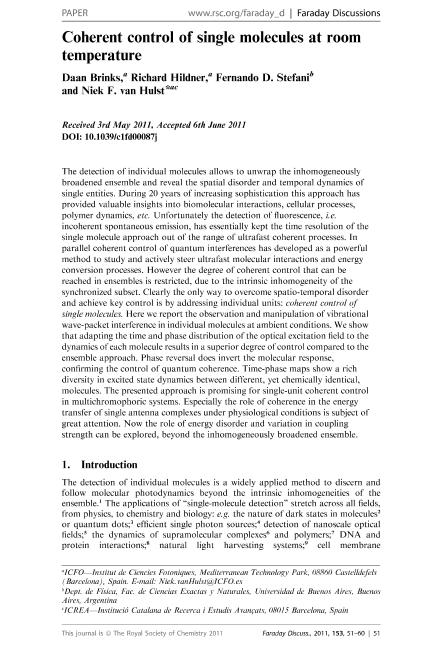Mostrar el registro sencillo del ítem
dc.contributor.author
Brinks, Daan
dc.contributor.author
Hildner, Richard
dc.contributor.author
Stefani, Fernando Daniel

dc.contributor.author
Van Hulst, Niek F.
dc.date.available
2019-01-29T20:22:46Z
dc.date.issued
2011-06
dc.identifier.citation
Brinks, Daan; Hildner, Richard; Stefani, Fernando Daniel; Van Hulst, Niek F.; Coherent control of single molecules at room temperature; Royal Society of Chemistry; Faraday Discussions; 153; 6-2011; 51-60
dc.identifier.issn
1364-5498
dc.identifier.uri
http://hdl.handle.net/11336/68916
dc.description.abstract
The detection of individual molecules allows to unwrap the inhomogeneously broadened ensemble and reveal the spatial disorder and temporal dynamics of single entities. During 20 years of increasing sophistication this approach has provided valuable insights into biomolecular interactions, cellular processes, polymer dynamics, etc. Unfortunately the detection of fluorescence, i.e. incoherent spontaneous emission, has essentially kept the time resolution of the single molecule approach out of the range of ultrafast coherent processes. In parallel coherent control of quantum interferences has developed as a powerful method to study and actively steer ultrafast molecular interactions and energy conversion processes. However the degree of coherent control that can be reached in ensembles is restricted, due to the intrinsic inhomogeneity of the synchronized subset. Clearly the only way to overcome spatio-temporal disorder and achieve key control is by addressing individual units: coherent control of single molecules. Here we report the observation and manipulation of vibrational wave-packet interference in individual molecules at ambient conditions. We show that adapting the time and phase distribution of the optical excitation field to the dynamics of each molecule results in a superior degree of control compared to the ensemble approach. Phase reversal does invert the molecular response, confirming the control of quantum coherence. Time-phase maps show a rich diversity in excited state dynamics between different, yet chemically identical, molecules. The presented approach is promising for single-unit coherent control in multichromophoric systems. Especially the role of coherence in the energy transfer of single antenna complexes under physiological conditions is subject of great attention. Now the role of energy disorder and variation in coupling strength can be explored, beyond the inhomogeneously broadened ensemble.
dc.format
application/pdf
dc.language.iso
eng
dc.publisher
Royal Society of Chemistry

dc.rights
info:eu-repo/semantics/openAccess
dc.rights.uri
https://creativecommons.org/licenses/by-nc-sa/2.5/ar/
dc.subject
Single Molecule
dc.subject
Ultrafast
dc.subject
Fluorescence
dc.subject.classification
Física Atómica, Molecular y Química

dc.subject.classification
Ciencias Físicas

dc.subject.classification
CIENCIAS NATURALES Y EXACTAS

dc.title
Coherent control of single molecules at room temperature
dc.type
info:eu-repo/semantics/article
dc.type
info:ar-repo/semantics/artículo
dc.type
info:eu-repo/semantics/publishedVersion
dc.date.updated
2019-01-29T18:06:17Z
dc.journal.volume
153
dc.journal.pagination
51-60
dc.journal.pais
Reino Unido

dc.description.fil
Fil: Brinks, Daan. Institut de Ciencies Fotoniques; España
dc.description.fil
Fil: Hildner, Richard. Institut de Ciencies Fotoniques; España
dc.description.fil
Fil: Stefani, Fernando Daniel. Universidad de Buenos Aires. Facultad de Ciencias Exactas y Naturales. Departamento de Física; Argentina. Consejo Nacional de Investigaciones Científicas y Técnicas; Argentina
dc.description.fil
Fil: Van Hulst, Niek F.. Institució Catalana de Recerca i Estudis Avancats; España. Institut de Ciencies Fotoniques; España
dc.journal.title
Faraday Discussions

dc.relation.alternativeid
info:eu-repo/semantics/altIdentifier/doi/http://dx.doi.org/10.1039/C1FD00087J
dc.relation.alternativeid
info:eu-repo/semantics/altIdentifier/url/https://pubs.rsc.org/en/Content/ArticleLanding/2011/FD/c1fd00087j
Archivos asociados
